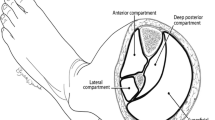Abstract
Patients with unrecognized or untreated extremity compartment syndrome are at high risk of amputation and the rates following major extremity vascular injury are high. Despite this, no clear evidence exists supporting the use of prophylactic fasciotomy. The procedure itself is associated with significant morbidity. Risk factors such as ischemia time, location of injury, concurrent injuries, and hypotension should be used to stratify which patients are most likely to benefit.
Access this chapter
Tax calculation will be finalised at checkout
Purchases are for personal use only
Similar content being viewed by others
References
Finkelstein JA, Hunter GA, Hu RW. Lower limb compartment syndrome: course after delayed fasciotomy. J Trauma. 1996;40:342–4.
Percival T, White J, Ricci M. Compartment syndrome in the setting of vascular injury. Persp Vasc Endovasc Ther. 2011;23(2):119–24.
Horn CE. Acute ischemia of the anterior tibial muscles and long extensor muscle of the toes. J Bone Joint Surg. 1945;27:615–22.
Hughes CW. Ischemic necrosis of the anterior tibial muscles due to fatigue. J Bone Joint Surg. 1948;30B:581–94.
Potter MBK, Freedman LBA, Shuler MS. Fasciotomy wound management and closure. Tech Orthop. 2012;2:62–6.
Rorabeck CH, Clarke KM. The pathophysiology of the anterior tibial compartment syndrome: an experimental investigation. J Trauma. 1978;18:299–304.
Ricci MA, Corbisiero RM, Mohamed F, Graham AM, Symes JF. Replication of the compartment syndrome in a canine model: experimental evaluation and treatment. J Invest Surg. 1990;3:129–40.
Percival TJ, Patel S, Markov NP, Morrison JJ, Spencer JR, Ross JD, Rasmussen TE. Prophylactic fasciotomy in a porcine model of extremity trauma. J Surg Res. 2015;193:449–57.
Branco BC, Inaba K, Barmparas G, Schnuriger B, Lustenberger T, Talving P, et al. Incidence and predictors for the need for fasciotomy after extremity trauma: a 10-year review in a mature level I trauma centre. Injury. 2011;42(10):1157–63.
Abouzzi Z, Nassoura Z, Inatury RR, Porter JM, Stahl WM. A critical reappraisal of indicatins for fasciotomy after extremity vascular trauma. Arch Surg. 1998;133(5):547–51.
Williams AB, Luchette FA, Papaconstantinou HT, Lim E, Hurst JM, Johannigman JA, et al. The effect of early versus late fasciotomy in the management of extremity trauma. Surgery. 1997;122:861–6.
Ritenour A, Dorlac WC, Fang R, Woods T, Jenkins DH, Flaherty SF, et al. Complications after fasciotomy revision and delayed compartment release in combat patients. J Trauma. 2008;64:S153–61.
Bermudez K, Knudson MM, Morabito D, Kessel O. Fasciotomy, chronic venous insufficiency, and the calf muscle pump. Arch Surg. 1998;133:1356–61.
Kashuk JL, Moore EE, Pinski S, et al. Lower extremity compartment syndrome in the acute care surgery paradigm: safety lessons learned. Patient Saf Surg. 2009;3:11.
Giannoudis PV, Nicolopoulos C, Dinopoulis H, Ng A, Adedapo S, Kind P. The impact of lower leg compartment syndrome on health related quality of life. Injury. 2002;33:117–21.
Fitzgerald AM, Gaston P, Wilson Y, Quaba A, McQueen MM. Long-term sequelae of fasciotomy wounds. Br J Plast Surg. 2000;53:690–3.
Farber A, Tan TW, Hamburg NM, Kalish JA, Joglar F, Onigman T, Rybin D, Doros G, Eberhardt RT. Early fasciotomy in patients with extremity vascular injury is associated with decreased risk of adverse limb outcomes: a review of the National Trauma Data Bank. Injury. 2012;43(9):1486–91.
Author information
Authors and Affiliations
Corresponding author
Editor information
Editors and Affiliations
Rights and permissions
Copyright information
© 2017 Springer International Publishing Switzerland
About this chapter
Cite this chapter
Hoehn, M., Brenner, M., Rasmussen, T.E. (2017). In Patients with Limb-Threatening Vascular Injuries, Is There a Role of Prophylactic Fasciotomy to Reduce Ischemic Injury?. In: Skelly, C., Milner, R. (eds) Difficult Decisions in Vascular Surgery. Difficult Decisions in Surgery: An Evidence-Based Approach. Springer, Cham. https://doi.org/10.1007/978-3-319-33293-2_17
Download citation
DOI: https://doi.org/10.1007/978-3-319-33293-2_17
Published:
Publisher Name: Springer, Cham
Print ISBN: 978-3-319-33291-8
Online ISBN: 978-3-319-33293-2
eBook Packages: MedicineMedicine (R0)



